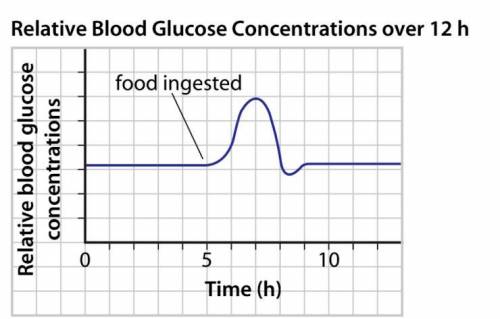
Answer questions (a) to (e) based on the attached graph (a) Describe what happened to the person’s blood glucose concentration at 5 h. (b) Identify the hormone that was released at 7 h, the gland that released it, and the stimulus. (c) Identify the hormone that was released at 8 h, the gland that released it, and the stimulus. (d) Predict how the graph would look if the person engaged in strenuous exercise at 12 h. What hormone would be released during exercise? (e) Suppose that the person has type 1 diabetes. When would he have taken insulin?


Answers: 2
Other questions on the subject: Biology

Biology, 22.06.2019 06:50, Shaylaharrison15
The kidney filters potentially toxic substances in the blood, and thus “clears” the blood of those substances. this clearance function is dependent upon and proportional to the diffusion gradient of the substance across filtering capillaries, i. e. if the concentration of the substance is doubled, twice as much will be cleared from each ml of blood that is filtered. suppose that the body produces a constant amount of a substance x per unit of time. the kidneys eliminate substance x at a rate directly proportional to the concentration of the substance and the volume of blood cleared each minute (c): elimination = c × [x], where [x] is the steady-state concentration of substance x. imagine an individual with an initial concentration of x equal to [x]0 who develops kidney disease. her baseline clearance c0 drops to one half of the original (½c0). what is the new steady state concentration of x? (for simplicity, assume that substance x is 100% filtered by the kidney).
Answers: 1

Biology, 22.06.2019 07:00, thomasalmo2014
Which best describes the scientific method? a. a path of clearly defined steps that must be followed in a particular order b. a possible answer to a scientific question based on knowledge or research c. the recipe for how to conduct an experiment that must be followed precisely d. the process of hypothesis and testing through which scientific inquiry occurs
Answers: 1

Biology, 22.06.2019 10:00, memphissmith5779
14. which of the following codons code for threonine? a. ucg b. ugu c. cga d. aca
Answers: 2

Biology, 22.06.2019 17:50, jaylenmiller437
How does a catalyst influence a chemical reaction?
Answers: 1
Do you know the correct answer?
Answer questions (a) to (e) based on the attached graph (a) Describe what happened to the person’s b...
Questions in other subjects:

Mathematics, 01.09.2019 20:20

Social Studies, 01.09.2019 20:20




Mathematics, 01.09.2019 20:20


Geography, 01.09.2019 20:20


Biology, 01.09.2019 20:20






